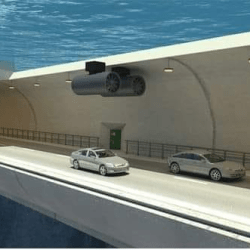A bridge is a structure built to span physical obstacles such as rivers, valleys, roads, or railways, providing passage for vehicles, pedestrians, or trains. Its purpose is to ensure smooth movement over challenging terrains or obstructions while enhancing connectivity and accessibility.
Bridges come in various forms depending on their function, design, and materials. Despite the diversity, all bridges share two fundamental parts:
Classification of Bridge Components
- Substructure Components: Located below the bridge bearing, these components transfer loads to the foundation and provide stability.
- Superstructure Components: Positioned above the bearing, these components directly support the traffic and distribute loads to the substructure.
The major components common to conventional bridge designs include:
Substructure Components
1. Abutments
- Location: At both ends of the bridge.
- Purpose: Act as vertical supports and serve as retaining walls to counteract earth pressure in approach areas.
- Key Role: Provide stability to the bridge ends and connect the bridge to the adjoining terrain.
2. Wing Walls
- Location: Adjacent to abutments.
- Purpose: Retain earth from the approach areas, preventing soil erosion.
- Design Note: Often integrated seamlessly with the abutments for aesthetic and functional continuity.
3. Piers
- Location: Between spans of the bridge.
- Purpose: Vertical supports that transfer loads from the superstructure to the foundation.
- Key Role: Enhance stability and support for longer spans by reducing stress on the deck.
4. Foundations
- Purpose: Serve as the base for all substructure components.
- Function: Transmit the loads of the entire bridge to the subsoil or bedrock.
- Design Consideration: Must be built on stable strata to ensure long-term durability and performance.
Superstructure Components
5. Bearing
- Purpose: Provide a resting surface between the bridge deck and piers or abutments.
- Function:
- Accommodate movements caused by temperature changes, load variations, or seismic activity.
- Reduce stresses and distribute loads evenly.
6. Decking
- Purpose: Forms the surface where traffic flows, supported by beams and girders underneath.
- Function:
- Ensures efficient load distribution.
- Withstands constant wear and tear from vehicles, pedestrians, or trains.
- Design Note: Must be durable, non-slippery, and resistant to environmental factors like heat and moisture.
7. Expansion Joint
- Purpose: Accommodates expansion and contraction due to weather variations.
- Function:
- Prevents cracking of the bridge slab deck.
- Maintains the structural integrity over time despite temperature-induced movements.
Other Essential Bridge Components
8. Pier Cap
- Location: Positioned on top of the piers.
- Purpose: Distributes loads from the superstructure to the piers uniformly.
9. Beams and Girders
- Purpose: Provide structural support for the deck.
- Function: Act as primary load-bearing components, transferring weight to the piers and abutments.
Bridge Design Considerations
- Type of Traffic: Pedestrian, vehicular, or railway.
- Span Length: Determines the number and size of piers required.
- Material Selection: Concrete, steel, or composite materials, based on cost, durability, and application.
- Environmental Conditions: Wind, water flow, seismic activity, and temperature variations.
Importance of Bridge Components
Each component of a bridge works in harmony to ensure:
- Structural Integrity: Stability under various load conditions.
- Safety: Smooth and safe passage for all types of traffic.
- Durability: Resistance to natural elements and wear over time.
- Load Management: Proper distribution to prevent structural failure.
By understanding the fundamental components and their roles, engineers can design and construct bridges that meet functional requirements while withstanding environmental challenges.





















